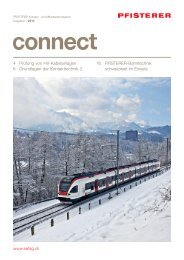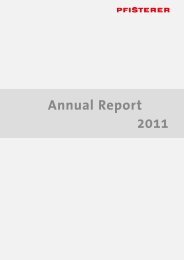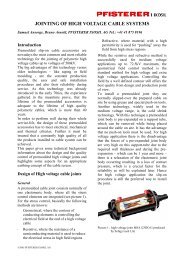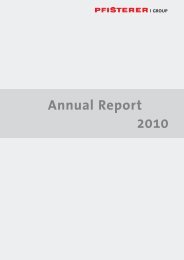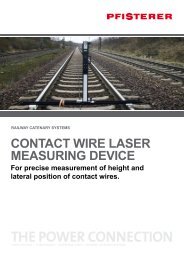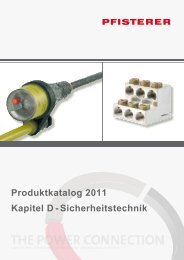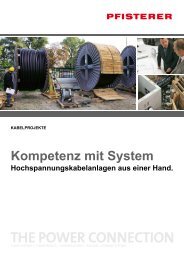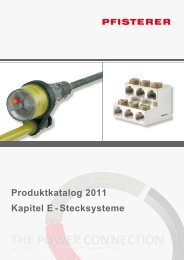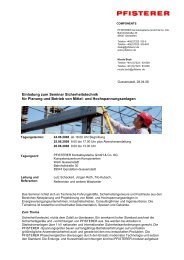vibrec 400 recorders - Pfisterer
vibrec 400 recorders - Pfisterer
vibrec 400 recorders - Pfisterer
You also want an ePaper? Increase the reach of your titles
YUMPU automatically turns print PDFs into web optimized ePapers that Google loves.
VIBRATION CONTROL<br />
OVERHEAD LINES<br />
Product CATALOGUE<br />
Vibrec tm <strong>400</strong> <strong>recorders</strong><br />
Advanced Solution for Conductor Vibration Measurements
VIBREC <strong>400</strong><br />
VIBREC <strong>400</strong><br />
VIBRATION measurements<br />
The Vibration Problem<br />
Aeolian vibrations of overhead line conductors and their<br />
detrimental effects are well known. These unavoidable<br />
vibrations are generated by wind flow and may cause fatigue<br />
failure in the conductor strands and other line components.<br />
To verify the conductor vibration severity, transmission line<br />
engineers, all over the world, measure the vibration intensity<br />
of transmission line conductors by using dedicated vibration<br />
<strong>recorders</strong>. Measurements made in accordance with the relevant<br />
IEEE and CIGRE guidelines, allow the evaluation of the<br />
endurance capability and the lifetime of the conductors.<br />
The Vibration Solution<br />
The VIBREC TM <strong>400</strong> <strong>recorders</strong> were developed specifically<br />
for this task. They record, convert and store data of conductor<br />
vibration by autonomous, long term, direct measurements<br />
at the points of probable damage, i.e. at the suspension<br />
and tension clamps, at damper, spacer or spacer<br />
damper clamps, at warning spheres and other fittings<br />
clamps.<br />
More than 500 PFISTERER SEFAG VIBREC <strong>recorders</strong><br />
are presently successfully in service all over the world and<br />
deliver day after day, throughout the years, valuable information<br />
about the vibration behaviour of the line conductors.<br />
In this way, vibration problems can be anticipated by improving,<br />
when necessary, the existing damping system.<br />
Features<br />
• Wind velocity measurements can be correlated with the<br />
vibration measurements.<br />
• 3D matrix for vibration amplitude, vibration frequency and<br />
wind velocity perpendicular to the conductor is available<br />
with user selectable class ranges.<br />
• Time histories show the shape of the actual measured<br />
vibration signal.<br />
• Fast Fourier Transformation (FFT) of measured signals<br />
shows dominating frequencies useful for proper damper<br />
selection.<br />
<br />
• User selectable setting of measurement cycle time, as well<br />
as quasi continuous measurements, can be used.<br />
• Up to 6 months of unattended operations at default setting<br />
(10 sec. sampling, 15 min. pause period) is possible.<br />
• Adjustable hardware and software filters for elimination of<br />
noise and for signal and data conditioning are user selectable.<br />
• Automatic start and stop function allows easier and trouble<br />
free installation and removal of the recorder.<br />
• Ambient temperature measurements are implemented.<br />
2
VIBREC <strong>400</strong><br />
VIBREC <strong>400</strong><br />
The LIFE <strong>400</strong> Software<br />
The VIBREC TM <strong>400</strong> recorder can be connected directly to any PC.<br />
The powerful communication software LIFE <strong>400</strong>, which is included<br />
with every VIBREC <strong>400</strong> free of charge, allows easy and<br />
flexible setting of the measuring parameters, such as:<br />
• Amplitude and frequency ranges<br />
• Wind and temperature classes<br />
• Sampling and pause periods<br />
• Automatic start and stop function of the measurements<br />
as well as comfortable data readout and elaboration including:<br />
• Maximum vibration amplitude vs. frequency<br />
• Accumulated stress curve<br />
• Number of cycles at each wind, frequency and amplitude level<br />
• Danger ratio at each wind, frequency and amplitude level<br />
• Wind and temperature distribution<br />
• Time history reconstructions of the most significant recording<br />
Amplitude classes<br />
Recorder No.: 628 Cycles per year<br />
Measurement No.: 4<br />
Wind array<br />
Recorder No.: 628 Number of entries [%]<br />
Measurement No.: 4<br />
Time history<br />
Recorder No.: 627<br />
Time [ms]<br />
Date/time: 25.04.2007 04:26:22<br />
Temperature array<br />
Recorder No.: 628 Number of entries [%]<br />
Measurement No.: 4<br />
The Wind Sensor<br />
The wind sensor is a high precision anemometer specifically designed to register<br />
the wind velocity component perpendicular to the conductor, synchronously with the<br />
corresponding vibration amplitudes and frequencies, enabling a unique correlation<br />
between these three important vibration parameters, in a 3D matrix. The wind sensor<br />
includes a temperature sensor that may be used to estimate the variations of the<br />
conductor tension and to consider possible ice deposits on the conductors during<br />
the measurement period.<br />
Special Application<br />
Damage at damper, spacer, spacer damper and warning sphere<br />
locations may occur due to poor damper design or incorrect<br />
hardware placement. The VIBREC <strong>400</strong> offers as an option the<br />
possibility of a remote sensor and enables vibration measurements<br />
at such locations.<br />
A special PT1A recorder equipped with a wire displacement<br />
transducer can be used for subspan oscillation measurements<br />
on lines in operation.<br />
The recorder is set-up for measurement of oscillation amplitude<br />
up to ± 381 mm (±15 inches) and oscillation frequencies in the<br />
range 0,2 ÷ 3,6 Hz.<br />
Extensive Testing<br />
The VIBREC <strong>400</strong> has successfully passed extensive tests such as:<br />
• Vibration test<br />
• Shock test<br />
• Power frequency and impulse voltage test<br />
• Corona test<br />
• High current test up to 1500 A<br />
• Climatic test<br />
• Functional and signal classification tests<br />
3
VIBREC <strong>400</strong><br />
Specification<br />
• Measuring parameters<br />
Vibration bending amplitude, vibration frequency, wind<br />
velocity component perpendicular to the conductor and<br />
ambient temperature.<br />
• Sensors<br />
LVDT displacement transducer (± 1 mm).<br />
Propeller anemometer (0 to 40 m/sec.).<br />
Silicone temperature sensor.<br />
• Optional<br />
Separate LVDT for remote measurements.<br />
Strain gauges for stress assessment.<br />
Wire displacement transducer for subspan oscillation<br />
measurements.<br />
• Frequency range<br />
0,2 – 200 Hz.<br />
• Signal detection<br />
Sampling rate of the signal: 2 kHz.<br />
Amplitude: peak-valley detection from two subsequent<br />
extremes.<br />
Frequency: inversion of time lag between two subsequent<br />
extremes.<br />
• Filtering<br />
Adjustable amplitude filter (default setting: 42 µm).<br />
• Data classification<br />
Events counting and storage in user selectable classes<br />
in a matrix with max. 32 amplitudes and max. 32 frequencies.<br />
With wind sensor data storage in 3D matrix with<br />
8 user selectable wind velocity classes with automatic<br />
correlation of wind data to vibration amplitude/frequency<br />
data. Temperature classification in max. 32 classes.<br />
• Storage memory<br />
Max. 10 9 events per matrix element.<br />
• Measurement cycle time<br />
15 min. default, can be preset from quasi continuous<br />
measurement to 8-hours intervals.<br />
• Sampling duration<br />
10 sec. default, can be preset from 0 to 65 sec. intervals.<br />
• Electronics<br />
Electronic circuits using SMD technology.<br />
Powerful microprocessor allows implementation of userdefined<br />
firmware and evaluation algorithms.<br />
Function control by LEDs.<br />
• Real-time clock<br />
Built-in real-time clock allows user selectable presetting of<br />
automatic start and stop function for measurements.<br />
• Communication<br />
Built-in serial interface (RS 232) allows direct connection to<br />
PC at 9`600 baud rate. USB port can also be used via a<br />
serial/USB adapter.<br />
• Utility software<br />
Utility programme Life TM <strong>400</strong> for parameter set-up and data<br />
read-out via PC included. It allows graphical presentation<br />
and data evaluation including lifetime estimation.<br />
• Power supply<br />
3 Lithium batteries (3,6 Volt) size C.<br />
The batteries have a six month life with default settings.<br />
A separate battery for memory backup (3 year life) is installed.<br />
• Temperature range<br />
– 40 °C to + 80 °C (– 30 °C to + 65 °C with wind sensor)<br />
• Degree of protection<br />
IP 66 (DIN).<br />
• Dimensions<br />
Aluminium alloy tube, length 306 mm, dia. 70 mm.<br />
• Weight<br />
Approximately 1,7 kg including batteries.<br />
• Test<br />
Extensive type, routine and field test are performed<br />
systematically.<br />
02/2008 / Version 01En I © PFISTERER SEFAG AG, 2008 I Subject to technical modifications I Concept & Realisation: www.starmedien.ch<br />
PFISTERER SEFAG AG Werkstrasse 7<br />
Phone +41 (0) 41 4997 272<br />
6102 Malters, Luzern<br />
Fax +41 (0) 41 4972 269<br />
Switzerland<br />
E-mail connect@sefag.ch<br />
www.pfisterer.com<br />
4



